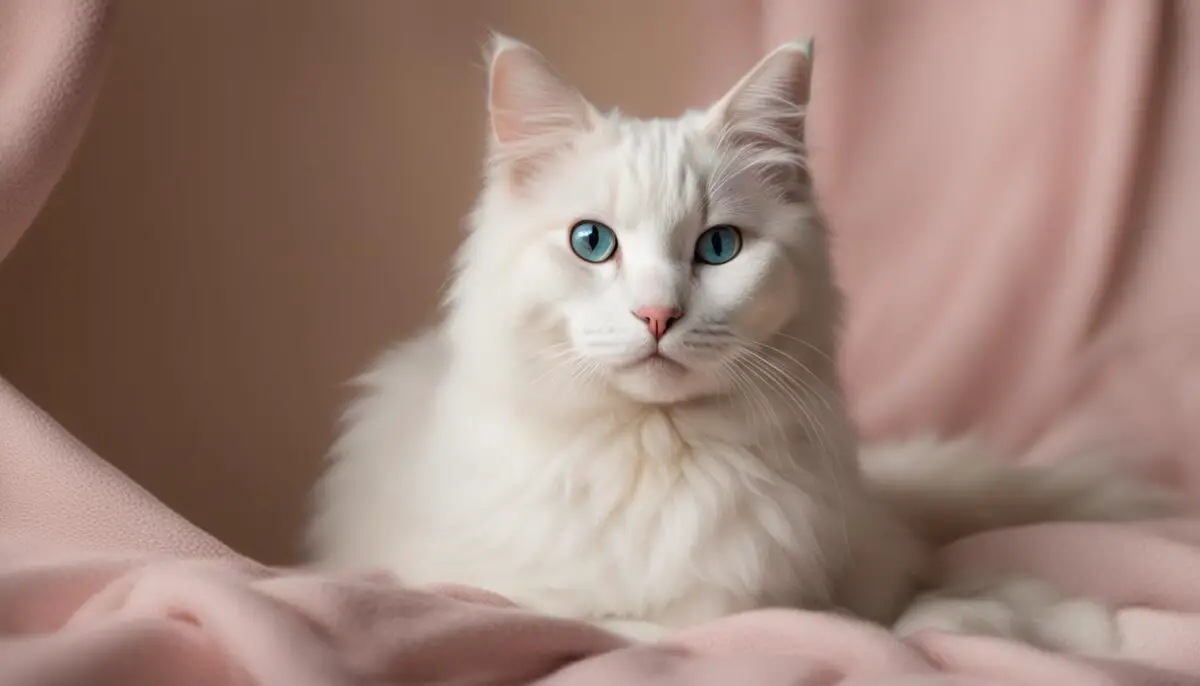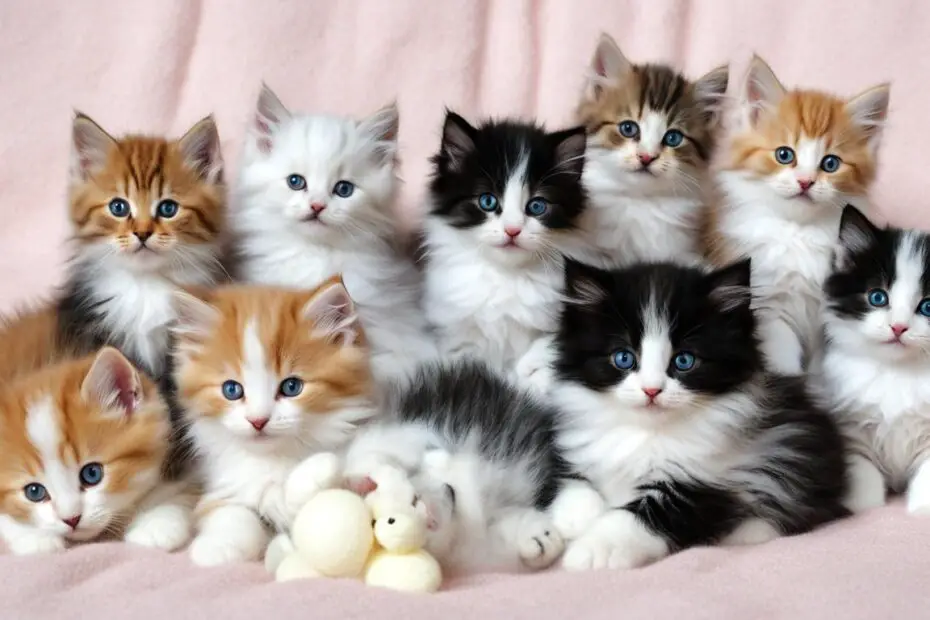More than 46 million homes in the U.S. have a cat, but for people with allergies, having a feline companion can be challenging. Fortunately, there are certain cat breeds known as “hypoallergenic” that produce lower levels of allergens. While no cat can be completely hypoallergenic, these breeds might be a better fit for people with allergies.
Key Takeaways:
- Hypoallergenic cat breeds produce lower levels of allergens.
- It’s important to do thorough research and spend time with the breed before adopting a hypoallergenic cat.
- Consult with an allergy specialist to determine the severity of your symptoms and take appropriate measures.
- Keep your home clean and consider potential dietary options to manage allergies.
- Cat allergies are primarily triggered by the protein Fel d 1, which is present in a cat’s saliva, dander, and other bodily fluids.
What Is a Hypoallergenic Cat?
When it comes to cats and allergies, finding the right feline companion can be a challenge. That’s where hypoallergenic cats come in. These cat breeds are known for producing lower levels of the proteins that trigger allergies, making them more tolerable for people with sensitivities. However, it’s important to note that there is no such thing as a completely hypoallergenic cat.
All cats produce allergens in their fur, saliva, and urine, but hypoallergenic cats have been found to have lower levels of these allergenic proteins. While this can help reduce the risk of triggering allergies, it’s still crucial for individuals with allergies to spend time with the breed and see how their own sensitivities react before making a decision.
Hypoallergenic cats provide an option for cat lovers who have allergies or are sensitive to allergens commonly found in cats.
“While hypoallergenic cats can offer some relief, it’s essential for individuals to understand that everyone’s allergies and sensitivities are different. What works for one person may not work for another,” says Dr. Emily Thompson, an allergy specialist.
However, by choosing a hypoallergenic cat breed, individuals with allergies can increase their chances of having a compatible and more comfortable feline companion. These breeds can provide the joy and companionship of having a cat without exacerbating allergy symptoms.
Let’s take a look at some of the popular hypoallergenic cat breeds that may be suitable for individuals with allergies:
- Siberian cats
- Siamese cats
- Bengal cats
- Russian Blue cats
- Sphynx cats
- Devon Rex cats
- Cornish Rex cats
- Javanese cats
- Balinese cats
- Oriental Shorthair cats
- Burmese cats
Each of these breeds has its own unique characteristics and coat types that make them less likely to trigger allergies. By researching and spending time with the breed of interest, individuals can determine which hypoallergenic cat is the best fit for their allergy relief needs.

Remember, while hypoallergenic cats can help reduce allergy symptoms, it’s important to consult with an allergy specialist before adopting one. They can provide personalized advice and recommendations based on an individual’s specific allergies and sensitivities. By taking the necessary precautions and finding the right hypoallergenic feline pet, individuals with allergies can enjoy the love and companionship of a cat without compromising their health.
11 Cats That Are ‘Hypoallergenic’
If you have allergies but still dream of owning a cat, there are several hypoallergenic breeds that you may consider. These breeds have lower allergen levels, making them more suitable for allergy sufferers.
Here are 11 cat breeds that are known for being hypoallergenic:
| Breed | Main Characteristics |
|---|---|
| Siberian | Thick, long fur with lower allergen levels |
| Siamese | Short fur and minimal shedding |
| Bengal | Pelt-like coat that produces fewer allergens |
| Russian Blue | Short, dense fur with lower allergen levels |
| Sphynx | Hairless breed with no fur to shed |
| Devon Rex | Curly coat that traps allergens |
| Cornish Rex | Soft, wavy coat with minimal shedding |
| Javanese | Silky, semi-long fur that produces fewer allergens |
| Balinese | Long, silky coat with lower allergen levels |
| Oriental Shorthair | Sleek coat with minimal shedding |
| Burmese | Short fur and smaller amounts of allergenic protein |
Each of these breeds has unique coat types and characteristics that contribute to their hypoallergenic qualities. However, it’s important to note that individual reactions to allergens can vary, so spending time with the breed and consulting with an allergy specialist is recommended before bringing a hypoallergenic cat into your home.
Remember, while these breeds may be hypoallergenic, no cat can be completely allergen-free. Regular grooming, keeping the environment clean, and minimizing exposure to allergens can help manage allergies even with hypoallergenic breeds.

Tips for Adopting a Hypoallergenic Cat
Adopting a hypoallergenic cat can be a wonderful way to enjoy the companionship of a feline friend without the discomfort of allergies. However, it’s important to take certain precautions and considerations before bringing a hypoallergenic cat into your home. Here are some helpful tips to ensure a successful adoption:
1. Do Thorough Research
Prior to adopting a hypoallergenic cat, it’s crucial to do your research and familiarize yourself with the different hypoallergenic breeds. Understanding their characteristics, grooming needs, and general temperament will help you make an informed decision and find the cat that best suits your lifestyle and preferences.
2. Spend Time with the Breed
Before committing to adopt a hypoallergenic cat, spend some time with the breed to gauge how your allergies react. Visit catteries or friends who own hypoallergenic cats to see if your allergy symptoms are manageable around them. This will give you a better idea of whether the breed is compatible with your sensitivities.
3. Consult with an Allergy Specialist
It’s essential to consult with an allergy specialist to determine the severity of your cat allergies. They can perform tests and provide valuable insights into how well you may tolerate a hypoallergenic cat. Allergy specialists can also offer advice on managing your symptoms and provide personalized recommendations based on your specific needs.
4. Keep Your Home Clean
Maintaining a clean and allergen-free environment is key to minimizing allergic reactions. Regularly vacuuming and dusting your home, especially areas where your cat spends time, can help reduce the presence of allergens. Consider using air purifiers with HEPA filters to further improve air quality and minimize airborne allergens.
5. Discuss Dietary Options with Your Veterinarian
Some hypoallergenic cat food formulas are specifically designed to reduce allergens and minimize the impact on allergic individuals. Consult with your veterinarian to explore dietary options that can help manage your allergies. They can recommend appropriate hypoallergenic cat food brands and advise on any necessary dietary adjustments for your new feline companion.
| Steps | Description |
|---|---|
| Research Hypoallergenic Breeds | Learn about different hypoallergenic cat breeds and their characteristics. |
| Interact with the Breed | Spending time with the breed to gauge personal allergies. |
| Consult an Allergy Specialist | Seek professional advice to assess allergy severity and receive personalized recommendations. |
| Maintain Clean Home | Regularly clean and vacuum to minimize allergens in your living environment. |
| Discuss Dietary Options | Talk to your veterinarian about hypoallergenic cat food and dietary adjustments. |
By following these tips, you’ll be well-prepared for a hypoallergenic cat adoption and can enjoy the company of a loving feline companion while minimizing the impact of allergies.

- First source
What Causes Allergies to Cats?
Contrary to popular belief, cat allergies are not caused by cat fur but by a protein called Fel d 1 that cats produce in their saliva. This protein can be present in a cat’s fur, blood, urine, saliva, and dander. Cat dander, which consists of tiny bits of dried, dead skin that cats naturally shed, is the primary trigger for allergies.
When cats groom themselves, they spread the Fel d 1 protein onto their fur, which then becomes airborne when the fur sheds. This allergen can remain in the environment for an extended period, making it difficult for individuals with cat allergies to escape exposure.
“Allergies to cats are caused by a protein called Fel d 1 found in the cat’s saliva, urine, and dander. When cats groom themselves, the saliva dries on their fur and becomes airborne when the fur sheds. The tiny particles of dander containing the Fel d 1 protein can trigger allergic reactions in sensitized individuals.” – Dr. Emma Johnson, Allergist
Cat dander can stick to clothing, furniture, and carpets, making it challenging to create an allergy-free environment. Even individuals who are not directly in contact with cats can still experience allergic reactions if they come into contact with surfaces contaminated with cat allergens.
To manage cat allergies, it is essential to minimize exposure to cat dander. Regular vacuuming, using air purifiers with HEPA filters, and washing hands and clothes after being in contact with cats can help reduce the presence of allergens in the environment. Additionally, keeping cats out of the bedroom and using allergen-resistant bedding can provide some relief for individuals with cat allergies.
Did You Know?
- It is estimated that approximately 10% of the population is allergic to cats.
- Fel d 1 is the most common cat allergen and is found in higher concentrations in male cats compared to female cats.
- Some cat breeds, such as the Siberian and Balinese, are believed to produce lower levels of Fel d 1 protein, making them a potential option for individuals with milder cat allergies.
Conclusion
While no cat breed can be considered completely hypoallergenic, there are cat breeds that are more suitable for allergy sufferers due to their lower allergen levels. If you have cat allergies, consider adopting one of the following hypoallergenic cat breeds: Siberian, Siamese, Bengal, Russian Blue, and Sphynx. These breeds have characteristics that make them less likely to trigger allergies, such as lower levels of allergens in their fur, saliva, and urine.
Before adopting a hypoallergenic cat, it’s important to consult with an allergy specialist to understand the severity of your symptoms. Spend time with the breed to see how your allergies react and ensure that they are the right fit for you. Doing thorough research and considering the specific needs of the breed is crucial in providing a safe and allergy-friendly environment.
Managing cat allergies involves more than just adopting a hypoallergenic cat. Keeping your home clean and free from allergens, such as regularly washing bedding and vacuuming, can help reduce exposure. Additionally, discussing potential dietary options with your veterinarian, such as a cat food formulated to reduce allergens, may further support allergy relief for both you and your feline companion.
FAQ
What is a hypoallergenic cat?
Hypoallergenic cats are cat breeds that produce lower levels of the proteins that trigger allergies. While no cat can be completely hypoallergenic, these breeds might be a better fit for people with allergies.
Which cat breeds are considered hypoallergenic?
Some cat breeds known for being hypoallergenic or having lower allergen levels include Siberian, Siamese, Bengal, Russian Blue, Sphynx, Devon Rex, Cornish Rex, Javanese, Balinese, Oriental Shorthair, and Burmese cats.
How can I determine if a hypoallergenic cat is suitable for me?
Before adopting a hypoallergenic cat, it’s important to spend time with the breed to see how your allergies react. Consulting with an allergy specialist to determine the severity of your symptoms is also recommended.
How can I manage my allergies if I have a hypoallergenic cat?
Keeping your home clean and discussing potential dietary options with your veterinarian, such as a cat food formulated to reduce allergens, can help manage allergies caused by hypoallergenic cats.
What causes allergies to cats?
Cat allergies are caused by a protein called Fel d 1 that cats produce in their saliva. This protein can be present in a cat’s fur, blood, urine, saliva, and dander. Cat dander, which consists of tiny bits of dried, dead skin that cats naturally shed, is the primary trigger for allergies.
Are there completely hypoallergenic cats?
No cat breed can be considered completely hypoallergenic. However, certain cat breeds have lower allergen levels and are more suitable for allergy sufferers.

